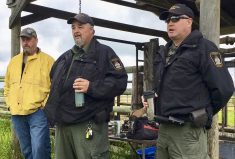To catch a wolf, you first have to learn how to think like one.
A round of “Think Like a Wolf” seminars in three northern towns was held earlier this month to help ranchers learn how to protect their herds from predators, said Barry Verbiwski, head of Manitoba Conservation’s fur-bearer and problem wildlife management unit.
“We were trying to provide the capacity at a local level so that people can help themselves,” said Verbiwksi.
The heavily attended two-day workshops were aimed primarily at livestock producers and licensed trappers. They were long on practical tips on animal husbandry techniques for preventing livestock losses due to predators as well as predator calling, trapping, hunting and fur preparation. Simple preventive measures were included, such as cleaning up afterbirth and proper disposal of dead-stock to prevent predators from seeing livestock as a food source.
Read Also

Pig transport stress costs pork sector
Popular livestock trailer designs also increase pig stress during transportation, hitting at meat quality, animal welfare and farm profit, Agriculture and Agri-Food Canada researcher says
GOOD NEIGHBOURS
Verbiwski, who owns property on the east side of the Duck Mountains, said livestock producers and predators generally get along.
Just because predators are spotted in the area, there’s no need to rush out and try to kill them, he said. Most common are the good kind – the ones that mind their own business without attacking livestock – and their very existence means that other potentially bad actors can’t move in.
That’s because wolves and coyotes are territorial by nature, and if their numbers are cleaned out in one area, sooner or later more will wander in and take up residence.
“We tell producers that if you have wolves or coyotes around, just leave them be,” said Verbiwski. “Unoccupied ranges will be filled up, and if those animals are experienced at killing livestock, you may end up having a problem where you didn’t have a problem.”
Landowners may shoot wolves or coyotes to protect their herds and flocks, but they are obligated to report the incident within 10 days to their local conservation officer. However, now that the season for wolves and coyotes has been opened up year round, they no longer need to report each kill if they purchase a $5 trapping licence.
LICENCE REQUIRED
However, to get a trapping licence, they must show proof that they either have held a licence before or have attended a mandatory trapper education course.
Funding for the seminars came in part from the Problem Predator Removal Program offered in conjunction with the Manitoba Trapper’s Association, which Verbiwski said has been “grossly undersubscribed” for some reason this year.
Last year, 300 incidents were dealt with, but this year, only 30 requests for help have been received.
“We don’t know why,” he added.
Manitoba Agricultural Services Corporation adjusters, who handle livestock loss claims, have been advised to tell ranchers with a verified predation claim to call the MTA and have a trapper or hunter assigned to remove the predator.
The two-day workshops, held in Swan River, Ashern, and Lac du Bonnet, were sponsored by Manitoba Conservation, the Manitoba Cattle Producers Association, Manitoba Model Forest and the Manitoba Trapper’s Association, with registration offered on a priority basis for livestock producers and licensed trappers. A one-day session was also held for Manitoba Conservation staff. “Trapper Gord” Klassen, an instructor at Dave Unger Trapper College in Debolt, Alta., was a featured speaker at the workshop.


















